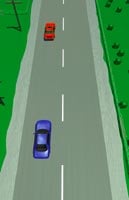What rule should you use to judge a safe following distance in wet or frosty conditions if driving a car?
 What rule should you use to judge a safe following distance in wet or frosty conditions if driving a car?
What rule should you use to judge a safe following distance in wet or frosty conditions if driving a car?
-
-
-
-
The correct answer is B
When it's wet and frosty it can take up to twice as long to stop, so you need to observe the four-second rule. This also applies any time if you're towing a trailer.
Stopping distances explained
Use the two-second rule in dry conditions.
Use the four-second rule in wet conditions or when towing a trailer in dry conditions.
On ice it can take up to 10 times the distance to stop.
The stopping distance is the distance it takes your vehicle to come to a complete stop. Many factors influence it, such as
- tyre tread depth - tyre performance drops off steeply in wet conditions once the tread depth falls below 3mm
- quality of your suspension - poor suspension will cause the vehicle to 'dive' under brakes, meaning less braking power can be applied through the rear wheels
- tyre inflation - over-inflation of tyres reduces the contact patch on the road
- whether you have anti-lock brakes - anti-lock brakes will stop you skidding and generally provide the optimum braking performance, especially if the ABS distributes the braking force so that each wheel is braking at its optimum level (electronic brakeforce distribution)
- the width of your tyres - wider tyres have a larger contact patch on the road
- the speed you are travelling - the faster you are going, the longer it will take to stop
- how much load your vehicle is carrying, including whether it is pulling a trailer - heavier vehicles take longer to stop
- the road surface - some surfaces have more friction than others
- your reaction time - reaction times are slowed by tiredness, dehydration, illness, alcohol and drug intake, and age.
Stopping distances will be longer with worn tyres, worn suspension, no ABS, a heavier vehicle, narrower tyres and a slippery road surface.
The table below from Noon (1994) is a selection of reasonable average values between tyre and road.
| Surface Type |
Coefficient of Friction (µ) |
| Gravel and dirt road |
0.35 |
| Wet, grassy field |
0.20 |
| Dry asphaltic concrete |
0.65 |
| Wet asphaltic concrete |
0.50 |
| Dry concrete |
0.75 |
| Wet concrete |
0.60 |
| Snow |
0.20 – 0.25 |
| Ice |
0.10 – 0.15 |
| Loose moist dirt that allows tyre to sink about 5cm |
0.60 – 0.65 |
The more water present on the road, the lower the coefficient of friction. As little as 0.4mm of water should be considered “wet” (Tulloch, Stocker 2011).
 What rule should you use to judge a safe following distance in wet or frosty conditions if driving a car?
What rule should you use to judge a safe following distance in wet or frosty conditions if driving a car?